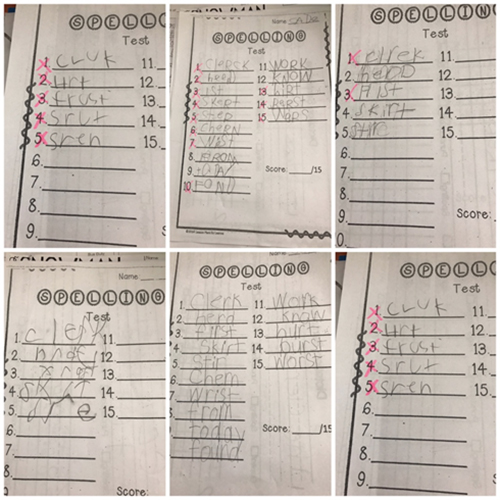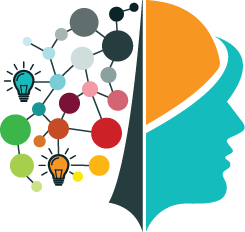Hidden Struggles: Diagnosing Learning Disabilities in the Classroom
Problems or People? The Struggle to Learn in the Classroom

The picture above shows 6 actual spelling tests administered to a second-grade public school classroom at the end of December in America.
None of these 6 children have been diagnosed with a learning disability and all are considered to have average intelligence.
While no one in this class of 19 students qualifies for special education services, the entire class has been taking part in a Response to Intervention (RTI) program since the beginning of this school year.
The RTI program provides modifications for students if needed, which is why some children only have five words written down.
Other interventions include:
- county training for the teacher on ways to individualize instruction to meet each student's learning style;
- support by available instructional coaches; and
- plans to notifify parents and the diagnostic team that each of these students are struggling.
The teacher was told that 5 of the 6 children represented by the tests pictured above need to more one-on-one instructional time and a multi-sensory approach to spelling. The county provided the teacher with a sound, research-based curriculum on how to provide this intervention.
These six children will move onto third grade in less then 5 months.
Do you see problems or people?
If you answered problems then please know the problems you see in this picture are being addressed.
All of the boxes have been checked, the school is in compliance with the governing educational laws.
I see people.
I see the five children who need more intervention than any one teacher can offer in a classroom.I see those five children being passed to the next grade and becoming a statistic.I see the second grader who believes that if they "try a little harder", they will learn to read, write, and spell.I see these same children carrying years of shame and guilt and the feeling of being “stupid” because they never learned to read and spell like his friends.I see kids who continue to “try harder” only to eventually realize that no matter how hard they work, they can’t figure it out.I see kids who can no longer handle the emotional toll of not being able to keep up and who turn to drugs to numb the pain.I see what is happening in the system.
But I still see people not problems.
I also see the one out of six students who come to school every day excited and eager to learn but is told to do work independently because the teacher is busy helping other children and they don't need any help.
After all, they're smart, they'll be fine, they can learn on their own.
I see this child being pulled and used as a “peer tutor” to provide extra assistance for the teacher.
I see this child begin to lose their excitement to learn because they come to school each day eager to learn something new but leave wondering if this is all there is?
The love for learning dwindles and they settle for “fine” because why not? All their parents really care about are “A”s and they don't even have to work very hard to get those.
I see a student who needs to be challenged but isn’t.
I see people not problems.
I see the regular education teacher. The person who has known she wanted to be a teacher since she was a little girl. She dreamed of inspiring and unlocking the beautiful minds that entered her classroom.
I see the teacher who goes home defeated every night with the images of the children who she knows she can not help, the students she knows that she is not giving enough attention too, and with the stress of knowing that her job depends upon classroom performance on standardized tests.
I see the teacher leaving school wondering what else she can do for those that did not “get it” but will get up the next day and try again.
I see people not problems.
I see the parents who sit across from me in search of answers. I hear the parents tell me that they were told that their child was “fine”.
I listen as they share their journey of school-based intervention and progress monitoring.
They tell me that they knew that their child was smart but did not know how to help.
They share how their child who once loved to go to school wakes up every morning with a stomachache and no longer enjoys school.
I see the pain on their face and the desperation in their voice.
I see people not problems.
I see people, not problems. And I offer hope.
My hope comes from my clinical experience and the personal lives that I see changed every day, when the root of the problem is identified, a plan is given, and follow through occurs.
Author Brené Brown says: “When we deny our stories, they define us. When we own our stories, we get to write a brave new ending.”
I have seen hundreds of children whose profile is reflected in the spelling tests pictured above.
Those same kids are now thriving. Confident in their ability to learn independently.
So how do we own our story?
We first have to be honest with ourselves and about the reality of the academic struggle.
We have to refuse to make up stories to justify mistakes or be quick to blame.
We need to allow ourselves and our kids to be human, accept their imperfections, learn from their failures, and strive to give them an environment that they can rise in, not just survive in.
The 9 facts below are listed to shine some light on academic realities we are facing and to empower those who ready to write their and their child's own ending.
- As of 2011, America was the only free-market country where the current generation was less educated than the previous one.
- Students learn to read from pre-k through second grade. From third grade on, students read to learn.
- Research tells us that students who have not mastered the skills necessary to read, write, and spell, efficiently by third grade, will continue to struggle academically.
- If a child has mastered a skill then a modification is not needed.
- Mastery of an academic skill does not equal a letter grade.
- A letter grade does not equal mastery of skills.
- Modifications change what a student is expected to learn. Students who receive modifications are not held to the same standard of their general education peers. This means the letter grade they receive is not equal to the same letter grade a student in the same grade earns without modifications.
- Response to Intervention (RTI) is not a way to diagnose a specific learning disability. You may learn important information about your child through the RTI process, but only an appropriate evaluation performed by a qualified professional can determine the presence of a qualifying disability.
- The earlier you identify a weakness the quicker it can be improved.
Click this link for a guide to the Response to Intervention process.
DISCOVER IF LEARNING DIFFICULTIES ARE AT THE ROOT OF LEARNING OR BEHAVIORAL STRUGGLES
If you suspect that learning difficulties may be underlying learning or behavioral struggles, we urge you to schedule a complimentary 10-minute phone call with Kyra Minichan, The Cognitive Emporium founder and developer of our unique P.A.T.H. assessment and treatment approach.

